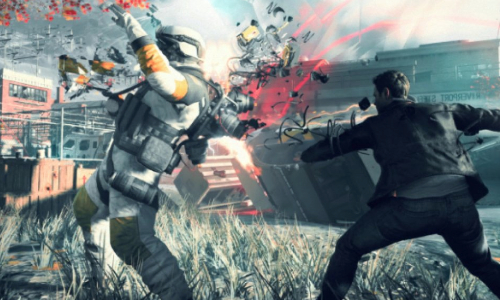Review: Quantum Break

There’s a scene in Quantum Break in which you walk through an eerily silent scene of unfurling devastation. A molotov cocktail hangs in the air, flames streaming behind it. Cars and containers glitch back and forth while the environment seethes and writhes in a ballet of polygons. It’s a reminder of the potential that this game so carelessly fritters away.
Remedy’s long-anticipated time-travel drama merges elements of traditional gaming with Netflix-style TV, smashing the two clumsily together to create something that’s far less than the sum of its parts.
You play as Jack Joyce, the brother of a scientist who returns to his home town to meet up with childhood friend, Paul. It turns out Paul has built a time machine which promptly messes up the very fabric of the universe. Time begins to “stutter” backwards and forwards and eventually it will stop altogether, ending all sentient life. On the plus side, Jack is fortuitously gifted a set of weirdly specific time skills that are perfectly suited to killing people and solving environmental puzzles.
Quantum Break manages to both over- and under-explain its mumbo-jumbo narrative. There are countless conversations about why time is knackered and how someone needs to get their hands on a special device that will resolve this garbage situation. But nobody even attempts to explain why Jack can throw what are essentially time grenades, or why he can reverse time, but only when standing at certain clearly marked points, in order to overcome a particular puzzle. Surely he can either reverse time or he can’t? It’s a hopelessly lazy way of shoehorning in a few extra things to keep you occupied. And don’t get me started on the ludicrous upgrade system involving the collection of glowing “chronon particles”, which are definitely part of science. Persistent niggles like these eventually conspire to shatter your belief in the game’s world.
Much of the pre-release hype focused on your ability to make choices that affect the narrative. At the end of each act, you take control of the story’s main antagonist and are presented with two possible “paths”, the results of which you can glimpse before you decide, because time travel. The process is undermined by the fact you can immediately restart the level and choose the other path if you wish.
And then before you know it, you’re watching the first of four live-action TV episodes starring Aidan Gillen and Lance Reddick from The Wire. Not a cut-scene; a 22-minute segment with all the production values of a Netflix series. Not one of the really good ones, but it’s watchable.
Unfortunately, beyond the branches triggered at the end of each act, what you do in the game has little bearing on what happens in the “live show”. This could be a comment on the nature of time, but I suspect it’s more a logistical imperative. Every now and then you pick up an item that triggers a “quantum ripple” – at one point I interacted with a sign bearing the name of a sports team. The result? Later in the game two characters walked past the same sign and said something like “huh, weird, what’s that sign doing here?” and then carried on with what they were doing, which was probably trying to stop time from collapsing.
In fact, for a game so obsessed with the idea of choice, you make surprisingly few. The levels are linear and your path through them is always clearly signposted (helped out by your handy “time vision”, which highlights any useful items). Each one is divided into distinct sections. You have the exploration bits, where you can mosey looking at notice boards and peering at computers, each one containing a single email, which is how computers work. This is the worst part of the game, forcing you to choose between reading lots of boring text or skipping ahead and potentially missing something important. For a game that prides itself on telling its story in a different way, this feels decidedly backwards.
The second part of the game is a common-or-garden platformer, where you’re tasked with jumping about like Lara Croft to get from point A to pint B, with no point C to complicate things.
Finally, there’s the killing part, and there’s an arcade-style freneticism to these sequences. They go like this: enter the allocated “arena” and you’ll trigger a brief cut-scene in which lots of men appear – they are bad men. You must kill the men with your trusty pistol, which has infinite bullets for no reason at all. Chaining your time skills together is fun at first but it’s essentially a cover-based, over-the-shoulder shooter with few real innovations.
There’s no overlap between these elements: you can’t shoot when you’re supposed to be jumping, or check an email when you’re supposed to be fighting. Everything is compartmentalised, which adds to the feeling you’re merely a passenger on this confusing ride.
Quantum Break reaches for the moon, and for that it deserves some credit. But while it flirts with brilliance, it never comes close to achieving it. It boils down to a passable action game, bogged down by anachronistic story-telling, welded to a forgettable TV series. It’s all the more frustrating given its potential: to use it’s own vernacular, if only the developers could go back in time and undo some of their poor choices, perhaps things would turn out better.

